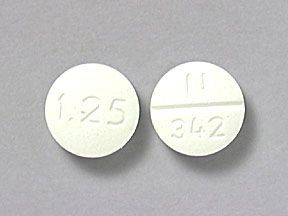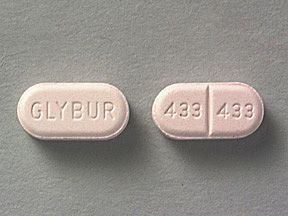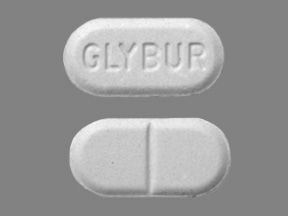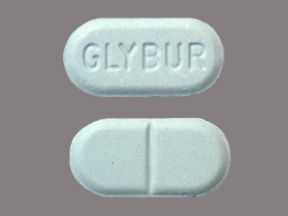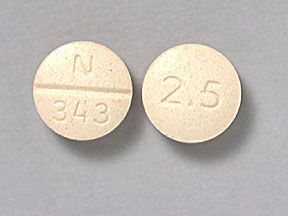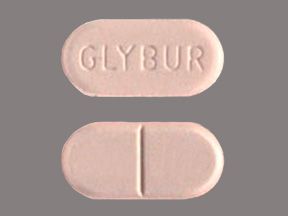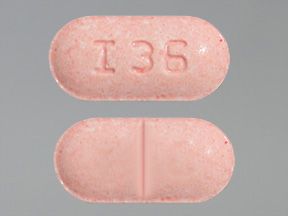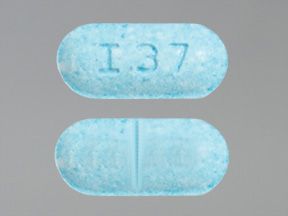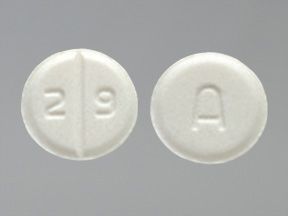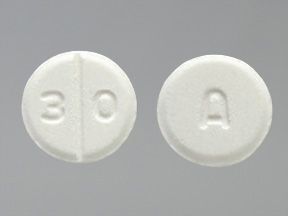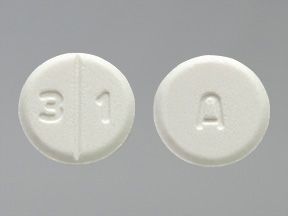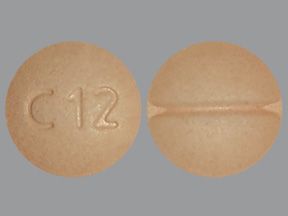Highlights for glyburide
- Glyburide oral tablet comes as brand-name drugs and as a generic drug. Brand names: Diabeta, Glynase PresTabs.
- Glyburide oral tablets come in two forms: regular and micronized. The micronized tablets contain smaller particles of the drug.
- Glyburide is used to treat type 2 diabetes.
- Low blood sugar (hypoglycemia) warning: Glyburide can cause low blood sugar. Symptoms can include:
- shakiness
- nervousness or anxiety
- sweating, chills, and clamminess
- irritability or impatience
- confusion
- rapid or fast heart rate
- lightheadedness or dizziness
- intense hunger
- nausea
- sleepiness
- blurred or impaired vision
- tingling or numbness in your lips or tongue
- headaches
- weakness or fatigue
- anger, stubbornness, or sadness
- lack of coordination
- nightmares or crying out during sleep
- seizures
- unconsciousness
If you don’t treat low blood sugar, you can have a seizure, pass out, and possibly develop brain damage. Low blood sugar can even be fatal. If you pass out because of a low sugar reaction or cannot swallow, someone will have to give you an injection of glucagon to treat the reaction. You may need to go to the emergency room.
Glyburide is a prescription drug. It comes as an oral tablet. These tablets come in two forms: regular and micronized. The micronized tablets contain smaller particles of the drug.
Glyburide is available as the brand-name drugs Diabeta and Glynase PresTabs. It’s also available in a generic form. Generic drugs usually cost less than the brand-name version. In some cases, they may not be available in every strength or form as the brand-name drug.
Glyburide may be used as part of a combination therapy. That means you need to take it with other drugs.
Why it’s used
Glyburide is used with diet and exercise to treat type 2 diabetes.
How it works
Glyburide belongs to a class of medications called sulfonylureas. A class of drugs is a group of medications that work in a similar way. These drugs are often used to treat similar conditions.
Glyburide helps release insulin from your pancreas. Insulin moves sugar from your bloodstream to your cells, which it provides with energy. This movement lowers your blood sugar levels.
Glyburide oral tablet doesn’t cause drowsiness, but it can cause other side effects.
More common side effects
The more common side effects that can occur with glyburide include:
- diarrhea
- dizziness
- headache
- heartburn
- nausea
- gas
- weight gain
If these effects are mild, they may go away within a few days or a couple of weeks. If they’re more severe or don’t go away, talk to your doctor or pharmacist.
Serious side effects
Call your doctor right away if you have serious side effects. Call 911 if your symptoms feel life-threatening or if you think you’re having a medical emergency. Serious side effects and their symptoms can include the following:
- allergic reaction, with symptoms such as:
- skin rash or blisters
- itching
- hives
- swelling of your face, lips, or tongue
- trouble breathing
- hypoglycemia (low blood sugar), with symptoms such as:
- sweating
- chills
- feeling nervous or anxious
- headaches
- dizziness
- shakiness
- blurred vision
- fast heart rate
- seizures
- loss of consciousness
- loss of coordination
- liver problems, with symptoms such as:
- dark urine
- jaundice (yellowing of your skin or the whites of your eyes)
- flu-like symptoms
- unusual bleeding or bruising
Treating low blood sugar
If you have a low blood sugar reaction, you need to treat it.
- For mild hypoglycemia (55–70 mg/dL), treatment is 15–20 grams of glucose (a type of sugar). You need to eat or drink one of the following:
- 3–4 glucose tablets
- a tube of glucose gel
- ½ cup of juice or regular, non-diet soda
- 1 cup of nonfat or 1% cow’s milk
- 1 tablespoon of sugar, honey, or corn syrup
- 8–10 pieces of hard candy, such as lifesavers
- Test your blood sugar 15 minutes after you treat the low sugar reaction. If your blood sugar is still low, then repeat the above treatment.
Once your blood sugar is back in the normal range, eat a small snack if your next planned meal or snack is more than 1 hour later.
When to call the doctor
Call your doctor if you have signs of low blood sugar or high blood sugar. If these symptoms are severe, call 911 or go to the emergency room.
Symptoms of low blood sugar include:
- sweating
- chills
- feeling nervous or anxious
- headaches
- dizziness
- shakiness
- blurred vision
- fast heart rate
- seizures
- loss of consciousness
- loss of coordination
Symptoms of high blood sugar include:
- frequent urination
- feeling very thirsty or hungry
- fatigue
- blurred vision
- bruises that heal slowly
- tingling, pain, or numbness in your hands or feet
Disclaimer: Our goal is to provide you with the most relevant and current information. However, because drugs affect each person differently, we cannot guarantee that this information includes all possible side effects. This information is not a substitute for medical advice. Always discuss possible side effects with a healthcare provider who knows your medical history.
Glyburide oral tablet can interact with other medications, vitamins, or herbs you may be taking. An interaction is when a substance changes the way a drug works. This can be harmful or prevent the drug from working well.
To help avoid interactions, your doctor should manage all of your medications carefully. Be sure to tell your doctor about all medications, vitamins, or herbs you’re taking. To find out how this drug might interact with something else you’re taking, talk to your doctor or pharmacist.
Examples of drugs that can cause interactions with glyburide are listed below.
Pulmonary arterial hypertension (PAH) drug
You shouldn’t take bosentan and glyburide at the same time. Taking these medications together may damage your liver.
Heartburn drug
If you’re taking cisapride with glyburide, your dosage of glyburide may need to be changed to make sure it’s working to control your blood sugar.
Antibiotic for infections and ulcers due to H. pylori
Taking clarithromycin with glyburide can increase the amount of glyburide in your body. This may cause symptoms of low blood sugar.
Drug for reflux, nausea, and vomiting
If you’re taking metoclopramide with glyburide, your dose of glyburide may need to be changed. This is done to make sure that it’s still controlling your blood sugar.
Drug for cancer, rheumatoid arthritis, and psoriasis
You shouldn’t take methotrexate and glyburide at the same time. Taking these medications together can cause methotrexate levels to increase in your body and become dangerous.
Drug for tuberculosis
Rifampin can lower the amount of glyburide in your body when taken with glyburide. This means that glyburide may not work as well to control your blood sugar.
Antacids
Taking antacids with glyburide may cause increased effects of glyburide in your body. This can cause symptoms of low blood sugar. Examples of these drugs include:
- cimetidine
Diuretics
Taking diuretics (water pills) with glyburide can cause high or low blood sugar in people with diabetes. You should monitor your blood sugar regularly if you’re taking the medications together. Your doctor may change your dose of glyburide or other diabetes medications.
Examples of diuretics include:
- bumetanide
- furosemide
- hydrochlorothiazide
- triamterene
Aspirin and other nonsteroidal anti-inflammatory drugs (NSAIDs)
Taking aspirin or other NSAIDs with glyburide can cause symptoms of low blood sugar. Examples of NSAIDs include:
- ibuprofen
- naproxen
Drugs for fungal or yeast infections,
Taking antifungal drugs with glyburide can increase the levels of glyburide in your body. This can cause symptoms of low blood sugar. Examples of these drugs include:
- fluconazole
- ketoconazole
Drug for gout
Taking probenecid with glyburide may increase the effect of glyburide and cause low blood sugar.
Drug for eye infections
Taking chloramphenicol with glyburide may increase the effect of glyburide and cause low blood sugar.
Monoamine oxidase inhibitors (MAOIs)
Taking these drugs with glyburide may increase the effect of glyburide and cause low blood sugar. Examples of MAOIs include:
- phenelzine
- selegiline
Drugs for blood pressure (beta blockers)
Taking these drugs with glyburide may increase the effect of glyburide and cause low blood sugar. Examples of beta blockers include:
- nadolol
- propranolol
- sotolol
Corticosteroids
Taking these drugs with glyburide can decrease the effect of glyburide and cause high blood sugar. Examples of these drugs include:
Antipsychotic drugs
Taking these drugs with glyburide can decrease the effect of glyburide and cause high blood sugar. Examples of these drugs include:
- clozapine
- olanzapine
- aripiprazole
- ziprasidone
Thyroid drugs
Taking these drugs with glyburide can decrease the effect of glyburide and cause high blood sugar. Examples of these drugs include:
- levothyroxine
- liotrix
- liothyronine
Hormone therapy or oral birth control pills
Taking these drugs with glyburide can decrease the effect of glyburide and cause high blood sugar. Examples of these drugs include:
- estrogen
- progesterone
Drug for seizures
Taking phenytoin with glyburide can decrease the effect of glyburide and cause high blood sugar.
Drugs for blood pressure (calcium channel blockers)
Taking these drugs with glyburide can decrease the effect of glyburide and cause high blood sugar. Examples of these drugs include:
- amlodipine
- verapamil
- nifedipine
Niacin
Taking niacin with glyburide can decrease the effect of glyburide and cause high blood sugar.
Disclaimer: Our goal is to provide you with the most relevant and current information. However, because drugs interact differently in each person, we cannot guarantee that this information includes all possible interactions. This information is not a substitute for medical advice. Always speak with your healthcare provider about possible interactions with all prescription drugs, vitamins, herbs and supplements, and over-the-counter drugs that you are taking.
This drug comes with several warnings.
Allergy warning
Glyburide can cause a severe allergic reaction. Symptoms may include:
- trouble breathing
- swelling of your throat or tongue
- hives
If you develop these symptoms, call 911 or go to the nearest emergency room.
Don’t take this drug again if you’ve ever had an allergic reaction to it. Taking it again could be fatal (cause death).
Alcohol interactions warning
Drinking alcohol can affect how well your body can control your blood sugar. You should limit how much alcohol you drink while you’re taking glyburide.
Warnings for people with certain health conditions
For people with diabetic ketoacidosis: Don’t use glyburide. Diabetic ketoacidosis is a serious complication of diabetes. It should be treated with insulin.
For people with type 1 diabetes: Don’t use glyburide for the treatment of type 1 diabetes. Glyburide works by increasing the amount of insulin your pancreas produces. With type 1 diabetes, your body no longer produces insulin, so glyburide won’t help.
For people with heart problems: Glyburide can increase your risk of a heart attack or stroke. This can sometimes be fatal. Tell your doctor if you have a heart condition before you start taking this drug.
For people with thyroid problems: Tell your doctor if you have a thyroid disorder because this affects how your body controls your blood sugar levels. Your doctor may need to change the dosage of your medications to help control your diabetes and thyroid.
For people with kidney disease: If you have kidney problems, you may not be able to clear this drug from your body as well as you should. Glyburide may build up in your body, which can cause lower blood sugar levels.
For people with liver disease: Your doctor may lower your dosage of glyburide if you have liver damage or liver disease.
Warnings for other groups
For pregnant women: Glyburide carries different risks depending on which type of glyburide you use.
- Glynase PresTabs (micronized glyburide): There aren’t enough studies done in pregnant women to show if the drug poses a risk to the pregnancy.
- Diabeta (glyburide): This form is a pregnancy category C drug. This means two things:
- Research in animals has shown adverse effects to the fetus when the mother takes the drug.
- There haven’t been enough studies done in humans to be certain how the drug might affect the fetus.
Tell your doctor if you’re pregnant or plan to become pregnant. Glyburide should be used during pregnancy only if the potential benefit justifies the potential risk.
If you become pregnant while taking this drug, call your doctor right away.
For women who are breastfeeding: Glyburide hasn’t been shown to pass through breast milk. However, you should tell your doctor if you’re breastfeeding. Your child will be monitored for signs of low blood sugar. You and your doctor may need to decide if you’ll take glyburide or breastfeed.
For seniors: People 65 years and older may have a stronger reaction to glyburide. It may also be more difficult to recognize the symptoms of low blood sugar. Your doctor may give you a lower dosage of this drug.
For children: The safety and effectiveness of glyburide haven’t been established in people younger than 18 years old.
All possible dosages and forms may not be included here. Your dose, form, and how often you take it will depend on:
- your age
- the condition being treated
- how severe your condition is
- other medical conditions you have
- how you react to the first dose
Drug forms and strengths
Generic: Glyburide
- Form: oral tablet
- Strengths: 1.25 mg and 2.5 mg
Generic: Glyburide
- Form: oral tablet (micronized)
- Strengths: 1.5 mg, 3 mg, and 6 mg
Brand: Diabeta
- Form: oral tablet
- Strengths: 1.25 mg, 2.5 mg, and 5 mg
Brand: Glynase PresTabs
- Form: oral tablet (micronized)
- Strengths: 1.5 mg, 3 mg, and 6 mg
Dosage for type 2 diabetes
Adult dosage (ages 18-64 years)
- Glyburide tablets
- Typical starting dosage: 2.5–5 mg taken once per day.
- Dosage adjustments: Your doctor may increase your dosage or switch you to taking two doses per day. They’ll decide this based on your blood sugar levels.
- Glyburide micronized tablets
- Typical starting dosage: 1.5–3 mg taken once per day.
- Dosage adjustments: Your doctor may increase your dosage each week by up to 1.5 mg per day based on your blood sugar levels.
Child dosage (ages 0–17 years)
A safe and effective dosage for children hasn’t been established.
Senior dosage (ages 65 years and older)
- Glyburide tablets
- Typical starting dosage: 1.25 mg taken once per day.
- Dosage adjustments: Dosage adjustments will be done slowly, if needed.
- Glyburide micronized tablets
- Typical starting dosage: 0.75 mg taken by mouth once per day.
- Dosage adjustments: Dosage adjustments will be done slowly, if needed.
Disclaimer: Our goal is to provide you with the most relevant and current information. However, because drugs affect each person differently, we cannot guarantee that this list includes all possible dosages. This information is not a substitute for medical advice. Always speak with your doctor or pharmacist about dosages that are right for you.
Glyburide oral tablet is used for long-term treatment. It comes with serious risks if you don’t take it as prescribed.
If you miss doses or don’t take it at all: If you don’t take glyburide as prescribed by your doctor, your blood sugar levels won’t be controlled. This can lead to complications from diabetes, such as nerve damage, heart disease, heart attack, stroke, and eye damage.
If you take too much: If you think you’ve taken too much of this drug, call your doctor or local poison control center. If your symptoms are severe, call 911 or go to the nearest emergency room right away.
Taking too much glyburide can cause severe low blood sugar.
What to do if you miss a dose: If you miss a dose of glyburide, take it as soon as you remember. If it’s almost time for your next dose, take only one dose at that time. Don’t take extra doses to make up for the missed dose.
How to tell if the drug is working: Your blood sugar levels should be lower.
Keep these considerations in mind if your doctor prescribes glyburide for you.
General
- Take glyburide with your first meal of the day. Don’t skip meals.
- Take glyburide with water.
Storage
- Store glyburide at room temperature between 59°F and 77°F (15°C and 25°C).
- Don’t freeze glyburide.
- Keep this drug away from light and high temperatures.
- Don’t store this medication in moist or damp areas, such as bathrooms.
Refills
A prescription for this medication is refillable. You should not need a new prescription for this medication to be refilled. Your doctor will write the number of refills authorized on your prescription.
Travel
When traveling with your medication:
- Always carry your medication with you. When flying, never put it into a checked bag. Keep it in your carry-on bag.
- Don’t worry about airport X-ray machines. They can’t harm your medication.
- You may need to show airport staff the pharmacy label for your medication. Always carry the original prescription-labeled container with you.
- Don’t put this medication in your car’s glove compartment or leave it in the car. Be sure to avoid doing this when the weather is very hot or very cold.
Self-management
While taking this medication, you’ll likely need to test your blood sugar level at home. You’ll need to learn how to do the following:
- use a blood glucose monitor to test your blood sugar regularly
- recognize the symptoms of high and low blood sugar
- treat low and high blood sugar reactions
In addition to the medication, you may also need:
- a safe needle disposal container
- alcohol swabs
- lancets to prick your finger to test your blood sugar
- blood sugar test strips
- blood glucose monitor to test you blood sugar at home
While taking this drug, be sure to carry with you a quick source of sugar, such as hard candy or glucose tablets. These items can help if you have symptoms of low blood sugar.
Clinical monitoring
Before you start and while you take glyburide, your doctor may check your:
- blood sugar levels
- glycosylated hemoglobin (A1C) levels (your doctor will do a test to measure your blood sugar control over the last 2–3 months)
- liver function
- kidney function
- heart function
- thyroid function
Your diet
Glyburide is used to treat diabetes along with diet changes and exercise. Talk to your doctor about how you should change your eating habits.
Sun sensitivity
Glyburide can make your skin more sensitive to the sun. This increases your risk of sunburn. Use sunscreen and wear protective clothing if you’re in the sun. Don’t use sun lamps or tanning beds or booths.
Hidden costs
In addition to the medication, you may also need to purchase:
- a safe needle disposal container
- alcohol swabs
- lancets to prick your finger to test your blood sugar
- blood sugar test strips
- a blood glucose monitor
There are other drugs available to treat your condition. Some may be better suited for you than others. Talk to your doctor about other drug options that may work for you.
Disclaimer: Healthline has made every effort to make certain that all information is factually correct, comprehensive, and up-to-date. However, this article should not be used as a substitute for the knowledge and expertise of a licensed healthcare professional. You should always consult your doctor or other healthcare professional before taking any medication. The drug information contained herein is subject to change and is not intended to cover all possible uses, directions, precautions, warnings, drug interactions, allergic reactions, or adverse effects. The absence of warnings or other information for a given drug does not indicate that the drug or drug combination is safe, effective, or appropriate for all patients or all specific uses.

